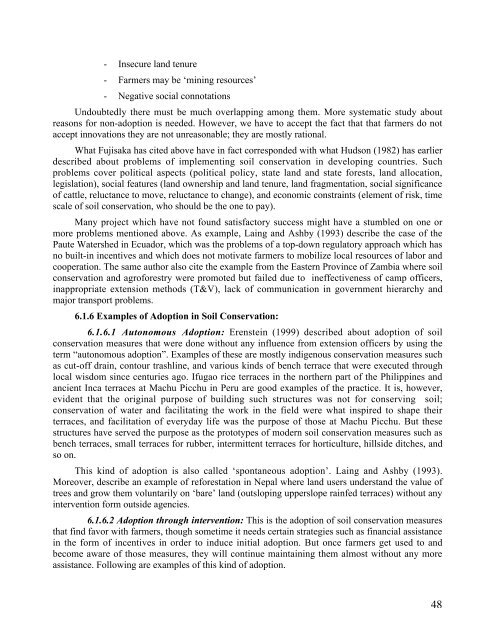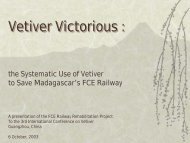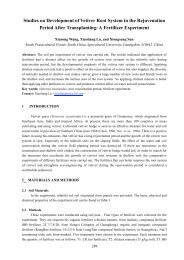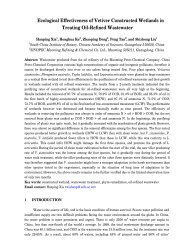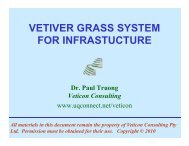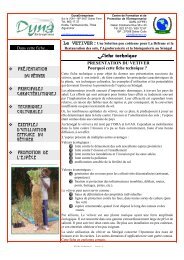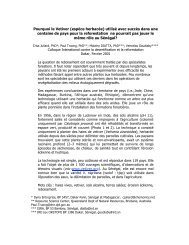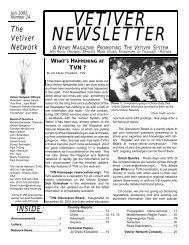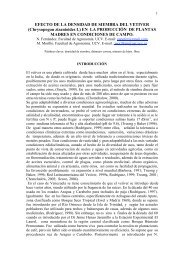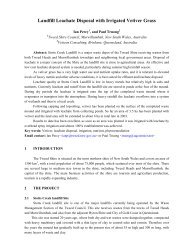Training manual - The Vetiver Network International
Training manual - The Vetiver Network International
Training manual - The Vetiver Network International
Create successful ePaper yourself
Turn your PDF publications into a flip-book with our unique Google optimized e-Paper software.
- Insecure land tenure<br />
- Farmers may be ‘mining resources’<br />
- Negative social connotations<br />
Undoubtedly there must be much overlapping among them. More systematic study about<br />
reasons for non-adoption is needed. However, we have to accept the fact that that farmers do not<br />
accept innovations they are not unreasonable; they are mostly rational.<br />
What Fujisaka has cited above have in fact corresponded with what Hudson (1982) has earlier<br />
described about problems of implementing soil conservation in developing countries. Such<br />
problems cover political aspects (political policy, state land and state forests, land allocation,<br />
legislation), social features (land ownership and land tenure, land fragmentation, social significance<br />
of cattle, reluctance to move, reluctance to change), and economic constraints (element of risk, time<br />
scale of soil conservation, who should be the one to pay).<br />
Many project which have not found satisfactory success might have a stumbled on one or<br />
more problems mentioned above. As example, Laing and Ashby (1993) describe the case of the<br />
Paute Watershed in Ecuador, which was the problems of a top-down regulatory approach which has<br />
no built-in incentives and which does not motivate farmers to mobilize local resources of labor and<br />
cooperation. <strong>The</strong> same author also cite the example from the Eastern Province of Zambia where soil<br />
conservation and agroforestry were promoted but failed due to ineffectiveness of camp officers,<br />
inappropriate extension methods (T&V), lack of communication in government hierarchy and<br />
major transport problems.<br />
6.1.6 Examples of Adoption in Soil Conservation:<br />
6.1.6.1 Autonomous Adoption: Erenstein (1999) described about adoption of soil<br />
conservation measures that were done without any influence from extension officers by using the<br />
term “autonomous adoption”. Examples of these are mostly indigenous conservation measures such<br />
as cut-off drain, contour trashline, and various kinds of bench terrace that were executed through<br />
local wisdom since centuries ago. Ifugao rice terraces in the northern part of the Philippines and<br />
ancient Inca terraces at Machu Picchu in Peru are good examples of the practice. It is, however,<br />
evident that the original purpose of building such structures was not for conserving soil;<br />
conservation of water and facilitating the work in the field were what inspired to shape their<br />
terraces, and facilitation of everyday life was the purpose of those at Machu Picchu. But these<br />
structures have served the purpose as the prototypes of modern soil conservation measures such as<br />
bench terraces, small terraces for rubber, intermittent terraces for horticulture, hillside ditches, and<br />
so on.<br />
This kind of adoption is also called ‘spontaneous adoption’. Laing and Ashby (1993).<br />
Moreover, describe an example of reforestation in Nepal where land users understand the value of<br />
trees and grow them voluntarily on ‘bare’ land (outsloping upperslope rainfed terraces) without any<br />
intervention form outside agencies.<br />
6.1.6.2 Adoption through intervention: This is the adoption of soil conservation measures<br />
that find favor with farmers, though sometime it needs certain strategies such as financial assistance<br />
in the form of incentives in order to induce initial adoption. But once farmers get used to and<br />
become aware of those measures, they will continue maintaining them almost without any more<br />
assistance. Following are examples of this kind of adoption.<br />
48


